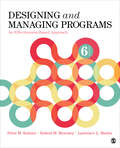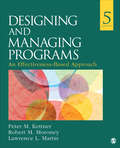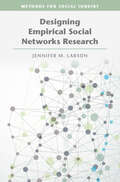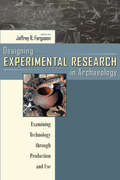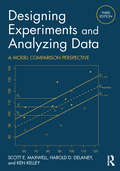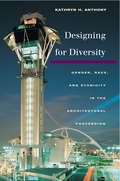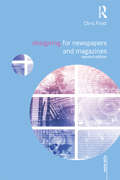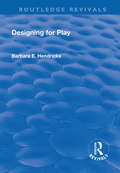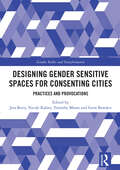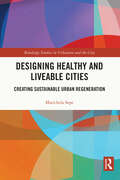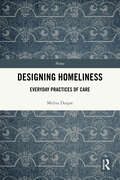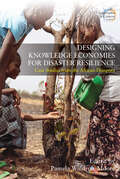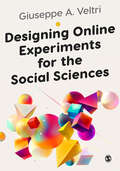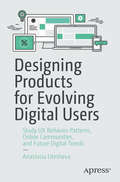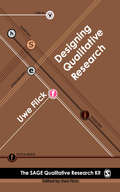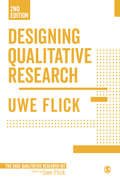- Table View
- List View
Designing and Managing Programs: An Effectiveness-Based Approach
by Peter M. Kettner Lawrence L. Martin Robert M. MoroneyThis classic text for social work and human services helps readers grasp the meaning and significance of measuring performance and evaluating outcomes. Hands-on and practical, Designing and Managing Programs incorporates the principles of effectiveness-based planning as it addresses the steps of designing, implementing, and evaluating a human services program at the local agency level. Written by leaders in the field, it guides students through the process from beginning to end. Meaningful examples—from problem analysis and needs assessment to evaluating effectiveness and calculating costs—enhance reader understanding of how concepts are implemented in the real world. The Sixth Edition contains new examples and references, and updates based on changes to federal regulations. An instructor website includes essay questions, PowerPoint slides, and suggested assignments designed by the authors.
Designing and Managing Programs: An Effectiveness-Based Approach
by Peter M. Kettner Lawrence L. Martin Robert M. MoroneyThis classic text for social work and human services helps readers grasp the meaning and significance of measuring performance and evaluating outcomes. Hands-on and practical, Designing and Managing Programs incorporates the principles of effectiveness-based planning as it addresses the steps of designing, implementing, and evaluating a human services program at the local agency level. Written by leaders in the field, it guides students through the process from beginning to end. Meaningful examples—from problem analysis and needs assessment to evaluating effectiveness and calculating costs—enhance reader understanding of how concepts are implemented in the real world. The Sixth Edition contains new examples and references, and updates based on changes to federal regulations. An instructor website includes essay questions, PowerPoint slides, and suggested assignments designed by the authors.
Designing and Managing Programs: An Effectiveness-Based Approach (SAGE Sourcebooks for the Human Services #Vol. 11)
by Robert M. Moroney Dr Peter M. Kettner Dr Lawrence L. MartinThe Fifth Edition of the classic Designing and Managing Programs for human services helps readers grasp the meaning and significance of measuring performance and evaluating outcomes. Authors Peter M. Kettner, Robert M. Moroney, and Lawrence L. Martin, all leaders in the field, incorporate the principles of effectiveness-based planning as they address the steps of designing, implementing, and evaluating a human services program at the local agency level. Meaningful examples at every stage of the process—from problem analysis and needs assessment to evaluating effectiveness and calculating costs—enhance reader understanding of how concepts are implemented in the real world.
Designing and Managing Programs: An Effectiveness-Based Approach (SAGE Sourcebooks for the Human Services #Vol. 11)
by Robert M. Moroney Dr Peter M. Kettner Dr Lawrence L. MartinThe Fifth Edition of the classic Designing and Managing Programs for human services helps readers grasp the meaning and significance of measuring performance and evaluating outcomes. Authors Peter M. Kettner, Robert M. Moroney, and Lawrence L. Martin, all leaders in the field, incorporate the principles of effectiveness-based planning as they address the steps of designing, implementing, and evaluating a human services program at the local agency level. Meaningful examples at every stage of the process—from problem analysis and needs assessment to evaluating effectiveness and calculating costs—enhance reader understanding of how concepts are implemented in the real world.
Designing and Managing Your Research Project: Core Skills for Social and Health Research
by David R Thomas Ian D HodgesWritten for advanced undergraduate students, postgraduate students planning theses and dissertations and other early career researchers, Designing and Managing Your Research Project helps you successfully plan and complete your research project by showing the key skills that you will need. The book covers: " choosing research methods " developing research objectives " writing proposals " literature reviews " getting ethics approval " seeking funding " managing a project " software skills " working with colleagues and supervisors " communicating research findings " writing reports, theses and journal articles " careers in research. Designing and Managing Your Research Project includes lots of examples, case studies and practical exercises to help you learn the research skills you will need and also to help you complete crucial project tasks. A key feature is its user-friendly guidance on planning projects and accessing information from the Internet.
Designing Empirical Social Networks Research (Methods for Social Inquiry)
by Jennifer M. LarsonA user-friendly introductory guide to the empirical study of social networks. Jennifer M. Larson presents the fundamentals of social networks in an intuition-forward way which guides theory-driven research design. Substantial attention is devoted to a framework for developing a network theory that will steer data collection to be maximally informative and minimally frustrating. Other features include: Coverage of a range of practical topics including selecting operationalizations, cutting survey costs, and cleaning data; A tutorial for getting started in analyzing networks in R; Technical sections full of examples, points to hone intuition, and practice problems with solutions. Designing Empirical Social Networks Research will be a valuable tool for advanced undergraduates, Ph.D. students in the social sciences, especially political science, and researchers across the social sciences who are new to the study of networks.
Designing Experimental Research in Archaeology: Examining Technology through Production and Use (G - Reference,information And Interdisciplinary Subjects Ser.)
by Jeffrey R. FergusonDesigning Experimental Research in Archaeology is a guide for the design of archaeological experiments for both students and scholars. Experimental archaeology provides a unique opportunity to corroborate conclusions with multiple trials of repeatable experiments and can provide data otherwise unavailable to archaeologists without damaging sites, remains, or artifacts. Each chapter addresses a particular classification of material culture-ceramics, stone tools, perishable materials, composite hunting technology, butchering practices and bone tools, and experimental zooarchaeology-detailing issues that must be considered in the development of experimental archaeology projects and discussing potential pitfalls. The experiments follow coherent and consistent research designs and procedures and are placed in a theoretical context, and contributors outline methods that will serve as a guide in future experiments. This degree of standardization is uncommon in traditional archaeological research but is essential to experimental archaeology. The field has long been in need of a guide that focuses on methodology and design. This book fills that need not only for undergraduate and graduate students but for any archaeologist looking to begin an experimental research project.
Designing Experiments and Analyzing Data: A Model Comparison Perspective, Third Edition (The\inquiry And Pedagogy Across Diverse Contexts Ser.)
by Scott E. Maxwell Harold D. Delaney Ken KelleyDesigning Experiments and Analyzing Data: A Model Comparison Perspective (3rd edition) offers an integrative conceptual framework for understanding experimental design and data analysis. Maxwell, Delaney, and Kelley first apply fundamental principles to simple experimental designs followed by an application of the same principles to more complicated designs. Their integrative conceptual framework better prepares readers to understand the logic behind a general strategy of data analysis that is appropriate for a wide variety of designs, which allows for the introduction of more complex topics that are generally omitted from other books. Numerous pedagogical features further facilitate understanding: examples of published research demonstrate the applicability of each chapter’s content; flowcharts assist in choosing the most appropriate procedure; end-of-chapter lists of important formulas highlight key ideas and assist readers in locating the initial presentation of equations; useful programming code and tips are provided throughout the book and in associated resources available online, and extensive sets of exercises help develop a deeper understanding of the subject. Detailed solutions for some of the exercises and realistic data sets are included on the website (DesigningExperiments.com). The pedagogical approach used throughout the book enables readers to gain an overview of experimental design, from conceptualization of the research question to analysis of the data. The book and its companion website with web apps, tutorials, and detailed code are ideal for students and researchers seeking the optimal way to design their studies and analyze the resulting data.
Designing Experiments for the Social Sciences: How to Plan, Create, and Execute Research Using Experiments
by Renita Coleman"This book is a must for learning about the experimental design–from forming a research question to interpreting the results this text covers it all." –Sarah El Sayed, University of Texas at Arlington Designing Experiments for the Social Sciences: How to Plan, Create, and Execute Research Using Experiments is a practical, applied text for courses in experimental design. The text assumes that students have just a basic knowledge of the scientific method, and no statistics background is required. With its focus on how to effectively design experiments, rather than how to analyze them, the book concentrates on the stage where researchers are making decisions about procedural aspects of the experiment before interventions and treatments are given. Renita Coleman walks readers step-by-step on how to plan and execute experiments from the beginning by discussing choosing and collecting a sample, creating the stimuli and questionnaire, doing a manipulation check or pre-test, analyzing the data, and understanding and interpreting the results. Guidelines for deciding which elements are best used in the creation of a particular kind of experiment are also given. This title offers rich pedagogy, ethical considerations, and examples pertinent to all social science disciplines.
Designing Experiments for the Social Sciences: How to Plan, Create, and Execute Research Using Experiments
by Renita Coleman"This book is a must for learning about the experimental design–from forming a research question to interpreting the results this text covers it all." –Sarah El Sayed, University of Texas at Arlington Designing Experiments for the Social Sciences: How to Plan, Create, and Execute Research Using Experiments is a practical, applied text for courses in experimental design. The text assumes that students have just a basic knowledge of the scientific method, and no statistics background is required. With its focus on how to effectively design experiments, rather than how to analyze them, the book concentrates on the stage where researchers are making decisions about procedural aspects of the experiment before interventions and treatments are given. Renita Coleman walks readers step-by-step on how to plan and execute experiments from the beginning by discussing choosing and collecting a sample, creating the stimuli and questionnaire, doing a manipulation check or pre-test, analyzing the data, and understanding and interpreting the results. Guidelines for deciding which elements are best used in the creation of a particular kind of experiment are also given. This title offers rich pedagogy, ethical considerations, and examples pertinent to all social science disciplines.
Designing for Diversity: Gender, Race, and Ethnicity in the Architectural Profession
by Kathryn H. AnthonyProviding hard data for trends that many perceive only vaguely and some deny altogether, Designing for Diversity reveals a profession rife with gender and racial discrimination and examines the aspects of architectural practice that hinder or support the full participation of women and persons of color. Drawing on interviews and surveys of hundreds of architects, Kathryn H. Anthony outlines some of the forms of discrimination that recur most frequently in architecture: being offered added responsibility without a commensurate rise in position, salary, or credit; not being allowed to engage in client contact, field experience, or construction supervision; and being confined to certain kinds of positions, typically interior design for women, government work for African Americans, and computer-aided design for Asian American architects. Anthony discusses the profession's attitude toward flexible schedules, part-time contracts, and the demands of family and identifies strategies that have helped underrepresented individuals advance in the profession, especially establishing a strong relationship with a mentor. She also observes a strong tendency for underrepresented architects to leave mainstream practice, either establishing their own firms, going into government or corporate work, or abandoning the field altogether. Given the traditional mismatch between diverse consumers and predominantly white male producers of the built environment, plus the shifting population balance toward communities of color, Anthony contends that the architectural profession staves off true diversity at its own peril. Designing for Diversity argues convincingly that improving the climate for nontraditional architects will do much to strengthen architecture as a profession. Practicing architects, managers of firms, and educators will learn how to create conditions more welcoming to a diversity of users as well as designers of the built environment.
Designing for Life
by Jaana Leikas José J. J. Cañas Pertti SaariluomaThis book reviews the history of technology and suggests howit will continue to develop in relation to human use. Technology and humans arebound together inextricably as more of our daily life, and even emotions, areinfluenced by objects which in turn are designed to reflect nature. Throughoutthe chapters, the authors take readers through the various uses of technology. They discuss archifact analysis, usability and cognitive engineering, as wellas motivation and emotion in user interface design. The book also cruciallyintroduces a new, holistic approach to designing human-technology interaction. The book is suitable for researchers, postgraduate andundergraduate students of cognitive and social psychology as well as all thosewho are interested intechnological design and its societal impact.
Designing for Newspapers and Magazines (Media Skills)
by Chris FrostA hugely beneficial introduction to students and professionals in print media and design, Designing for Newspapers and Magazines offers guidance on how to produce attractive publications and how to tailor them to their target audience using colour, text placement, typography and images.Written by an experienced journalist and designer, the book details the elements of good design and provides instruction on how to get the most of computers and computer-aided design.The book examines a broad range of local and national publications including The Sun, The Daily Mirror and Glamour magazine and explains the reasoning that underpins their design choice, including: how to set up a new publication planning an edition of a newspaper or magazine typography and working with text working with images and technical production designing pages and how to use colour design and journalism ethics a glossary of journalistic and design terms
Designing for Play (Routledge Revivals)
by Barbara E. HedricksThis title was first published in 2001. Architects, landscape designers, builders, gardeners and teachers have all at some time been called upon to design a play area. Unfortunately, this diversity has not resulted in a similar diversity of design solutions for this very problematic task. Despite a proliferation of "how to" books on this subject, playgrounds have remained virtually the same throughout the world since their creation over a century ago.This is not a "how to" design book. Instead, based on thirty years experience as a specialist play area designer, Barbara Hendricks details a radically new approach, applying cutting-edge thinking from child development and child psychology to find innovative design solutions, challenging the established notions of play provision. Covering key sociological, public policy, environmental and design issues, this book provides designers with an exploration of, and guide to, designing from a "child's eye" view of the world.Beautifully crafted and copiously illustrated with numerous examples of recently designed playgrounds, this book is not only stimulating and informative, but fun to read and seriously playful in itself.
Designing Gender Sensitive Spaces for Consenting Cities: Practices and Provocations (Gender, Bodies and Transformation)
by Jess Berry Nicole Kalms Timothy Moore Gene BawdenThis edited collection investigates gender-sensitive spaces, design practices, and provocations that challenge the complex social and material structures that shape inequities of access and inclusion in the urban environment.Designing Gender Sensitive Spaces for Consenting Cities: Practices and Provocations centres intersectional, gender-sensitive approaches to design in the urban environment as an integral strategy in combating spatial inequities. Through an investigation of design-led methods, project case studies, activist interventions, and processes of resistance and agency, this volume offers new thinking and practical approaches to demonstrate how design might shift towards safer and more inclusive cities for women, gender-diverse people, and LGBTIQ+ communities.This book will appeal to practitioners, scholars, and students of urbanism, design, planning, architecture, and geography, as well as government and non-profit organisations that are interested in gender and equality and can influence the future narratives of cities.
Designing Healthy and Liveable Cities: Creating Sustainable Urban Regeneration (Routledge Studies in Urbanism and the City)
by Marichela SepeIn the last ten years, concepts such as urban health and liveability have become ever more present in urban planning studies. Many companies rank the most liveable city in the world or in a nation, and many indicators are used to try to measure factors which can report the health of a place by investigating it in different ways. While it is possible to understand why a place is liveable – due to the liveability and health concepts that are being more and more explored in urban studies, and the strong influence coming from other disciplines – it is difficult to design a place that is certain to be healthy and liveable. Accordingly, aim of this book is, after the definition of the field of investigation concerning sustainable regeneration trough topics such as resilience, adaptation, health, and mixed connections, to illustrate the present-day approaches to the analysis and design of healthy places, and in particular the original Healthy Pl@ce Design method, flexible and repeatable in different contexts. The method aims to identify sustainable urban liveability and healthiness and the factors which make places liveable and healthy from users' points of view and identifying design interventions that can enhance or create both urban liveability and health. Emblematic case studies carried out in Europe, Canada and China – Bordeaux, Copenhagen, Hamburg, Madrid, Newcastle–Gateshead, Nice, Dublin, Vancouver and Wuhan – constitute the empirical part of the book, detailed with surveys, questionnaires, images and maps. The theoretical framework – built on contemporary issues – and international case studies make this book both attractive and scientific, adding a new stone on the sustainable city construction and opening it to a particularly wide readership, including scholars, students, administrators and professionals.
Designing Homeliness: Everyday Practices of Care (Home)
by Melisa DuqueDesigning Homeliness: Everyday Practices of Care proposes an interdisciplinary lens to investigate home. The book situates homeliness as a continual process of creating, maintaining, and restoring meanings and experiences of home. Melisa Duque draws from her design ethnographic practice with people using smart home lighting, gardening, jigsaw puzzles, and op-shopping to present everyday examples in dialogue with theoretical discussions, revealing the role of homeliness in generating wellbeing. The research projects featured in this book were conducted in rural, regional, remote, and metropolitan areas in Australia, at familiar and unfamiliar living sites, including people’s homes, a mental health hospital unit, a residential aged care facility, and a charity shop revaluing domestic things. This book offers conceptualisations and practical tools to advance home studies while engaging with broader discussions on ageing, wellbeing, and sustainability. Led by design research and social science analysis, this book will be of value for students, researchers, and practitioners at these intersections, including design, anthropology, and human geography.
Designing Knowledge Economies for Disaster Resilience: Case Studies from the African Diaspora (Catastrophes in Context #7)
by Pamela Waldron-MooreDisaster research has been studied from many angles, seldom targeting its implications for vulnerable territories in Africa. Entities most subject to the effects of climate change are often undeveloped and located in disadvantaged regions. Post-disaster communities need to scrutinize the social, political, economic, and cultural structures that stagnate sustainable growth. Acknowledging that low economic development and high climate costs cannot coexist, this collected volume interrogates the challenge for disaster-prone territories to determine strategies for restructuring and redesigning their environment. This book proposes the creation of knowledge economies, whereby empowered communities may produce innovative knowledge translatable across the African diaspora.
Designing Luxury Brands: The Science Of Pleasing Customers' Senses (Management For Professionals)
by Diana DervalThis book shows how to build successful luxury brands using the power of sensory science and neuro-physiology. The author introduces – based on inspiring business cases like Tesla, Louis Vuitton, Chanel, Hermès, Moncler, Louboutin, or Sofitel in industries such as Fashion, Automotive or Leisure – groundbreaking scientific methods - like the Derval Color Test® taken by over 10 million people - to predict luxury shoppers’ preferences and purchasing patterns and illustrates common and unique features of successful luxury brands. Through various practical examples and experiments, readers will be able to build, revamp, or expand luxury brands and look at luxury from a new angle.
Designing Online Experiments for the Social Sciences
by Giuseppe VeltriThis book guides you through designing and implementing an online experiment in social science research in a clear and straightforward manner. At an approachable pace, it covers foundational principles of good experimental design before setting out best practice for how to design and conduct web experiments, taking into account the specific methodological challenges of working online with digital tools. The book: Offers practical advice for approaching every stage of the research process Breaks real-world examples into easy to follow steps Focuses on how to make good decisions and choose the right design for your research project This pragmatic guide helps beginner researchers get started with online experiments confidently. It is supported by online resources such as case studies which allow you to see the concepts in practice, and weblinks to tools and resources to aid you.
Designing Online Experiments for the Social Sciences
by Giuseppe VeltriThis book guides you through designing and implementing an online experiment in social science research in a clear and straightforward manner. At an approachable pace, it covers foundational principles of good experimental design before setting out best practice for how to design and conduct web experiments, taking into account the specific methodological challenges of working online with digital tools. The book: Offers practical advice for approaching every stage of the research process Breaks real-world examples into easy to follow steps Focuses on how to make good decisions and choose the right design for your research project This pragmatic guide helps beginner researchers get started with online experiments confidently. It is supported by online resources such as case studies which allow you to see the concepts in practice, and weblinks to tools and resources to aid you.
Designing Products for Evolving Digital Users: Study UX Behavior Patterns, Online Communities, and Future Digital Trends
by Anastasia UteshevaDigital user behavior is evolving at an ever-increasing pace, and predicting future trends is a booming business as a result. Users associate technology with their identities now more than ever, and it is up to you as a product designer to enhance their experience for the better. Designing Products for Evolving Digital Users is a 21st century handbook that helps you do just that. By providing insights that allow you to study UX (user experience) behavior patterns, online communities, and future digital trends, Designing Products for Evolving Digital Users instills confidence and fact-based foundations for your digital creations. Author Anastasia Utesheva expertly teaches you how to account for the way the technology impacts the identity of users and how that identity shifts through ongoing interaction with a product or service. She also brings in important case studies on social media, gaming, eRetail, and more to illustrate past examples of technology’s profound impact on communal and individual identity. Digital product design’s ultimate end goal is end user satisfaction. While a myriad of material is available out there consisting of simple tips and tricks for optimal digital design, Designing Products for Evolving Digital Users is a rare and remarkable title that cohesively accounts for all environmental factors involved. Comprehend how distributed technology impacts creation and negotiation of identity and explore communities that form around digital products. UX designers, futurists, students, and industry veterans alike have an abundance of invaluable learning ahead of them in Designing Products for Evolving Digital Users. What You Will LearnLearn how to design digital products/services that resonate with and transform identity of usersStudy how digital impacts formation of identityConsider how digital technology has impacted our world and implications for future digital trendsWho This Book Is For UX designers, digital product creators, entrepreneurs, educators, philosophy of technology enthusiasts, futurists
Designing Qualitative Research (Qualitative Research Kit)
by Dr Uwe FlickProviding a comprehensive guide to devising an effective research design, Uwe Flick discusses each stage of the process of designing qualitative research in detail, including formulating a research design, selecting an appropriate strategy, conceptual framework and data source, and collecting and analyzing data.
Designing Qualitative Research (Qualitative Research Kit)
by Dr Uwe FlickThis concise introduction to qualitative research design will help you to think through the questions you need to ask when embarking on your research. Uwe Flick discusses each stage of the process of designing qualitative research,from turning an idea into a research question, selecting a sample, choosing an appropriate strategy, developing a conceptual framework and data source, and preparing for data collecting and analysis. This book can be used alongside other titles in the SAGE Qualitative Research Kit but can equally be used on its own. It is an invaluable companion to students and scholars embarking on research in in the social sciences, health, business and education.
Designing Qualitative Research (Qualitative Research Kit)
by Dr Uwe FlickThis concise introduction to qualitative research design will help you to think through the questions you need to ask when embarking on your research. Uwe Flick discusses each stage of the process of designing qualitative research,from turning an idea into a research question, selecting a sample, choosing an appropriate strategy, developing a conceptual framework and data source, and preparing for data collecting and analysis. This book can be used alongside other titles in the SAGE Qualitative Research Kit but can equally be used on its own. It is an invaluable companion to students and scholars embarking on research in in the social sciences, health, business and education.
